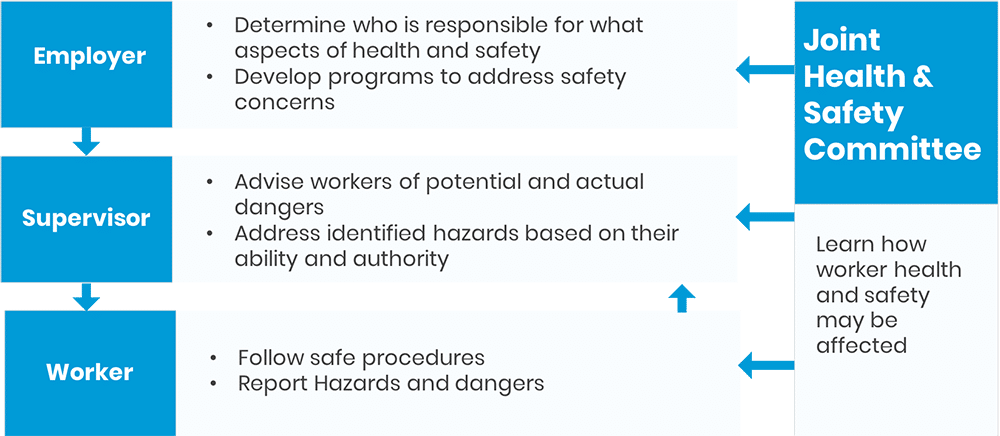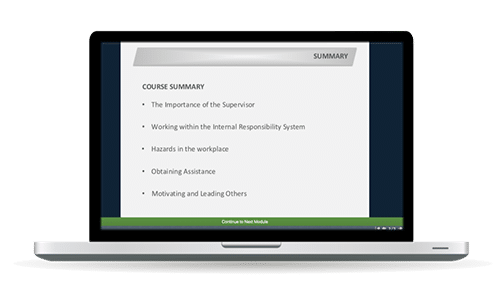Do you know your responsibilities when it comes to health and safety? If you don’t, you’re not alone. Owners, managers, and workers across the province think it’s someone else’s job. But it’s not. Every single person in an organization has health and safety responsibilities.
In Ontario, under the Occupational Health and Safety Act (OHSA), this concept is referred to as the Internal Responsibility System (IRS). With a strong IRS, everyone understands their contribution to a healthy workplace. When this happens, workers stay safe and productivity and profits increase. One survey of CFOs revealed that every $1 invested in injury prevention returns $2 or more. Don’t wait until someone gets hurt or dies on the job to start fulfilling your role in the IRS.
Employer Responsibilities
Employers have a lot of responsibility when it comes to workplace safety. Chief among them is the responsibility to take every reasonable precaution for the safety of workers. This encompasses the concept of due diligence. So, while everyone in the workplace contributes to safety, being able to prove due diligence is up to the employer. The employer is also the party responsible for ensuring that the IRS is established, promoted, and that it functions successfully.
Duties of an employer in Ontario are covered in section 25 and 26 of the OHSA. These include the duty to:
- Comply with all regulations made under OHSA
- Develop and implement an occupational health and safety program and policy
- Develop and implement a workplace violence and harassment policy (s.32.0.1)
- Provide information, instruction, and supervision to a worker to protect the health and safety of that worker.
- Establish and cooperate with the Joint Health and Safety Committee (JHSC)

Who is the employer?
The employer can be a corporation or an individual owner. In a large organization, the employer is typically represented by senior management. They may delegate the tasks required to fulfill their duties to Human Resources or Health and Safety Managers. But, they cannot outsource the legal responsibility. In a small organization, the employer is often the owner themselves. In this case, they may be the one carrying out the tasks involved in fulfilling the employer duties.
Learn more about how Human Resources has evolved to include Health and Safety
Supervisor Responsibilities
Supervisors have the same overall responsibility to ensure the safety of workers. According to section 27 of the OHSA, supervisors must take every precaution reasonable in the circumstances for the protection of the worker. Other duties include:
-
- Ensuring workers work in compliance with health and safety policies and procedures, and the OHSA
- Ensuring that personal protective equipment (PPE) is worn when necessary
- Advising workers of any potential or actual dangers known to them
- Providing workers with written instructions on any measures and procedures to be taken for the workers’ protection
- Offering training and education about potential or actual hazards
In Ontario, supervisors are required to complete Health and Safety Awareness Training to help prepare them to fulfill their safety duties.

Who is a supervisor?
A supervisor is a person appointed, by an employer, who has charge of a workplace or authority over a worker. A supervisor can be called a manager, team lead, director and so on. They may not have an official supervisory title, but if they have authority over a worker, they are considered a supervisor. Authority refers to a specific power the supervisor has to ensure a worker’s compliance with directions
Worker Responsibilities
Worker Responsibilities
Safety isn’t just the job of management. Safety is a personal responsibility. The OHSA outlines the responsibilities of workers as well. While the main one is to work safely, workers are also responsible for:
- Wearing appropriate personal protective equipment
- Operating equipment in a safe manner
- Working in compliance with OHSA and its regulations
- Reporting any known workplace hazards or OHSA violations
- Knowing their rights under the OHSA
Every worker in Ontario must complete Health and Safety Awareness Training to learn about their rights and responsibilities.
The above responsibilities are a statutory requirement. And likely a condition of your worker’s employment. But there are so many other ways workers can contribute to a positive safety culture. Not least among them is joining the workplace’s JHSC.
JHSC Responsibilities
The JHSC is another integral part of the IRS. It is comprised of workers and management. The committee inspects the workplace and meets regularly with the goal of creating a safe workplace. The JHSC cannot function without the active participation of workers. Whether that is by being on the committee or by readily engaging with the JHSC when they have questions or concerns.
Learn more about the roles and responsibilities of the JHSC
It Pays to Be Responsible
While no one can truly put a price on a life saved or a serious injury being prevented, studies have shown that workplaces who invest in health and safety reap financial rewards. In an executive survey, over 60% of CFOs reported that each $1 invested in injury prevention returned $2 or more. Over 40% said productivity was the greatest benefit of an effective workplace safety program.
Fines, Jail Time, and Worse for Those Who Fail to Fulfill Their Duties
In 2018, 907 convictions occurred under the OHSA, resulting in $12.6 million dollars in fines. Ministry of Labour Inspectors can show up to your workplace at any time. If they notice any contraventions of the OHSA, they can fine the offender $250 to $650 on the spot. More serious contraventions of the OHSA will be sent to court, where the consequences can be much steeper:
- A fine of up to $100,000 for an individual person and/or up to 12 months imprisonment
- A fine of up to $1,500,000 for a corporation
If you don’t think people are being held accountable for unfulfilled duties, think again. In May 2019, the owner of an Ontario Roofing company was sentenced to 7 days in jail after his fourth conviction under the OHSA. No injuries were involved. However, he repeatedly failed to fulfill his duties as an employer under the OHSA.
Supervisors can also be personally prosecuted for contraventions of the OHSA. In June 2019, a supervisor was fined $5,000 after three workers received burns from an arc flash while working for an electrical company. In addition, the employer was ordered to pay $55,000 as a result of the conviction.
While supervisors and employers can face jail time and large fines, workers pay the consequences with their wellbeing. They can end up injured or dead. In 2018, 218 people died from work-related injuries or illnesses in Ontario.
Free Tool – Safety Culture Review
 Every person in an organization can either contribute or detract from the culture. Workers, supervisors, leaders, and JHSC members all have a role to play in maintaining and promoting a positive safety culture at work.
Every person in an organization can either contribute or detract from the culture. Workers, supervisors, leaders, and JHSC members all have a role to play in maintaining and promoting a positive safety culture at work.
Use our tool to evaluate how well each workplace party is contributing to the organization’s safety culture. A member from each workplace can rank themselves in areas such as:
- Communication
- Accident Reporting
- Participation
- Accountability
The tool will give you an overall Safety Culture Score and reveal areas for improvement.